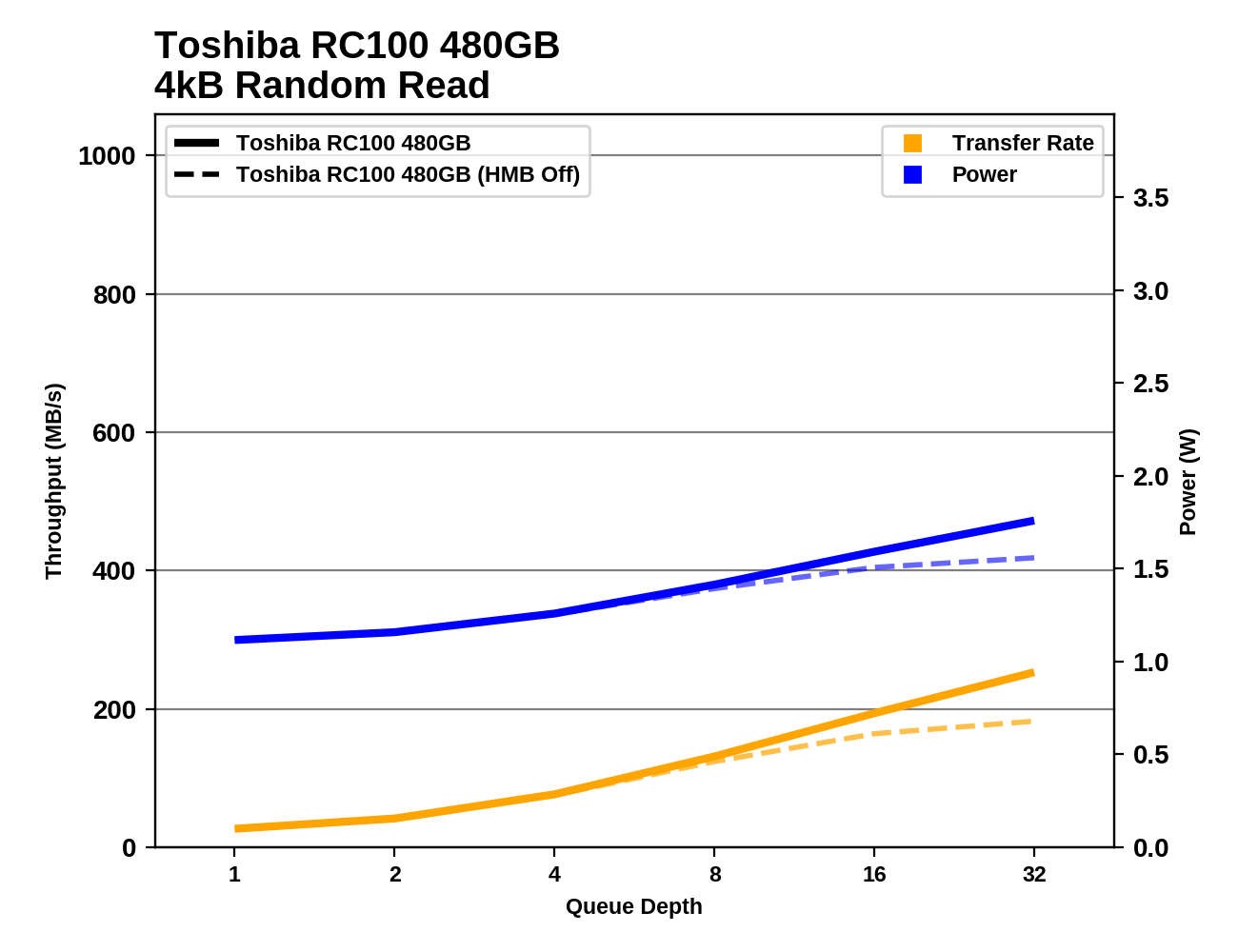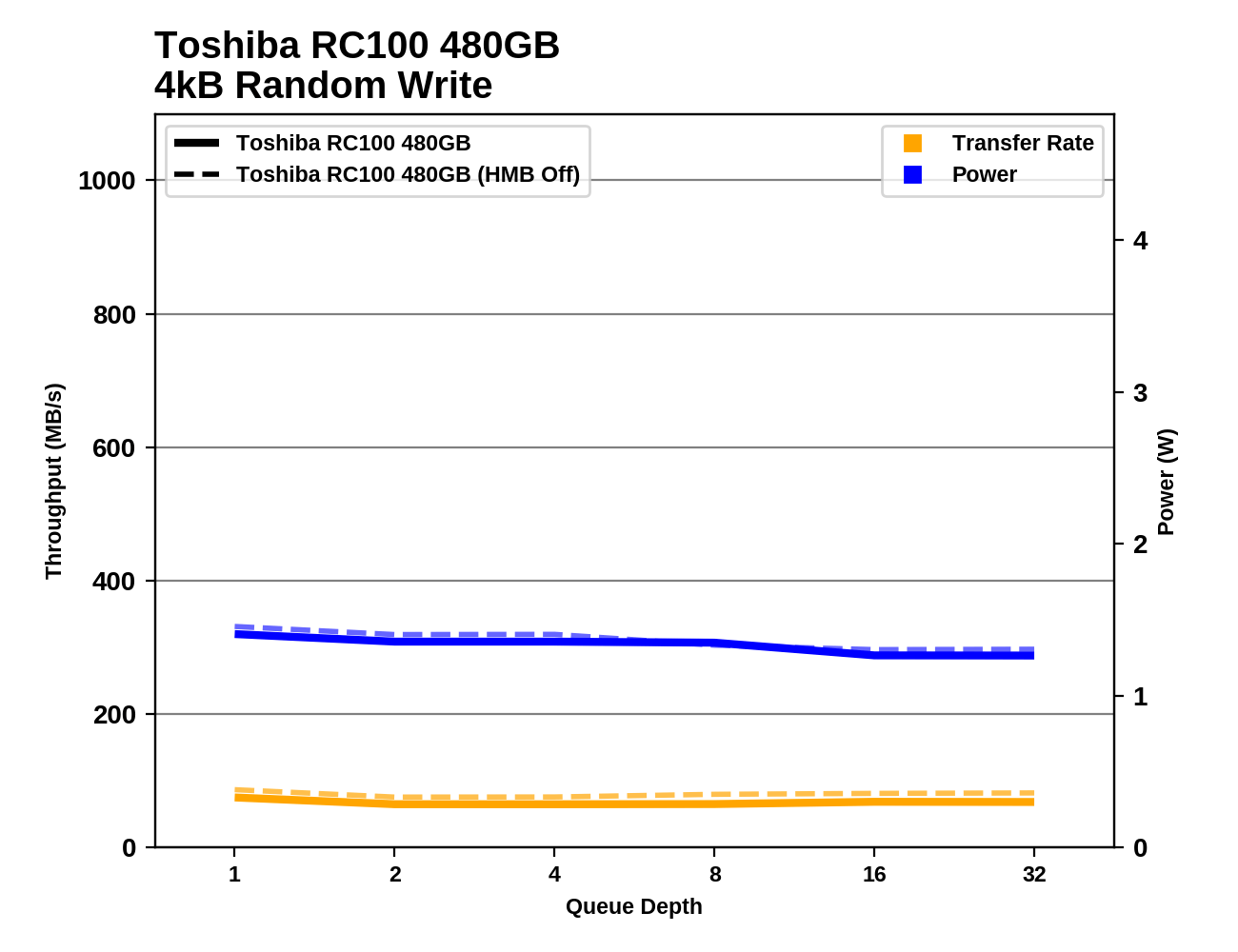The Toshiba RC100 SSD Review: Tiny Drive In A Big Market
by Billy Tallis on June 14, 2018 9:00 AM ESTRandom Read Performance
Our first test of random read performance uses very short bursts of operations issued one at a time with no queuing. The drives are given enough idle time between bursts to yield an overall duty cycle of 20%, so thermal throttling is impossible. Each burst consists of a total of 32MB of 4kB random reads, from a 16GB span of the disk. The total data read is 1GB.

The Toshiba RC100 surprises with excellent burst random read performance, and even when HMB is off it outperforms the other low-end NVMe SSDs we've tested.
Our sustained random read performance is similar to the random read test from our 2015 test suite: queue depths from 1 to 32 are tested, and the average performance and power efficiency across QD1, QD2 and QD4 are reported as the primary scores. Each queue depth is tested for one minute or 32GB of data transferred, whichever is shorter. After each queue depth is tested, the drive is given up to one minute to cool off so that the higher queue depths are unlikely to be affected by accumulated heat build-up. The individual read operations are again 4kB, and cover a 64GB span of the drive.

On the longer random read test that covers a broader span of the drive than HMB can help with, the Toshiba RC100's scores are unsurprisingly in last place among NVMe drives, but it's not too far behind the Intel 600p.
 |
|||||||||
| Power Efficiency in MB/s/W | Average Power in W | ||||||||
The RC100 clearly uses less power during random reads than any other NVMe SSD we've tested, but the poor performance when reading from a wide span of the drive means the efficiency is just a bit below average.
 |
|||||||||
For the larger RC100, the HMB feature has a fairly large impact on random read performance at high queue depths even though the HMB cache is too small to completely handle this workload. At low queue depths and for the smaller 240GB model at any queue depth, HMB has minimal impact on random read performance.
Random Write Performance
Our test of random write burst performance is structured similarly to the random read burst test, but each burst is only 4MB and the total test length is 128MB. The 4kB random write operations are distributed over a 16GB span of the drive, and the operations are issued one at a time with no queuing.

With HMB enabled, the burst random write performance of the Toshiba RC100 is decent, but without HMB it can't beat a mainstream SATA drive.
As with the sustained random read test, our sustained 4kB random write test runs for up to one minute or 32GB per queue depth, covering a 64GB span of the drive and giving the drive up to 1 minute of idle time between queue depths to allow for write caches to be flushed and for the drive to cool down.

Once again, the large working set size of this test compared to the small host buffer size used by the RC100 condemns the drive to last place. The margin between the RC100 and the next-slowest NVMe drive is much larger than it was for the sustained random read test. HMB actually slightly hurts performance here.
 |
|||||||||
| Power Efficiency in MB/s/W | Average Power in W | ||||||||
Power consumption is slightly higher for random writes than for random reads, but still well below the other NVMe SSDs. The performance is low enough that the power efficiency score for the RC100 is worse than all the competition.
 |
|||||||||
Random write performance from the RC100 is low at any queue depth. The drive doesn't have enough memory to perform effective write combining and caching under this sustained load, while high-end drives usually manage to significantly improve performance when working with a large queue of write operations.










62 Comments
View All Comments
Samus - Thursday, June 14, 2018 - link
I didn’t consider it either. The WD Black hit the sweet spot for me, picked the 512GB up on sale for $150...Ryan Smith - Thursday, June 14, 2018 - link
"My issue with Anandtech was the sole posting of the 970 EVO review and no 970 PRO review now for over 7 weeks."On the hardware side of matters, Samsung sampled us the 970 EVO at launch. They did not sample us the 970 PRO at that time. So that greatly impacts what gets reviewed and when.
XabanakFanatik - Thursday, June 14, 2018 - link
I'm very confused at why Samsung would have sampled several other review sites with both drives (obvious by the reviews of both being posted together before launch) but have skipped on sampling Anandtech at the same time.Maybe it was a mistake? Maybe it was intentional? Maybe the 970 Pro would not have shined as well in the thorough testing you do here?
In any case, I need to apologize. Sorry, Billy, for jumping you about it. Thanks for an answer.
Ryan Smith - Friday, June 15, 2018 - link
Samsung essentially does random sampling. We got the EVO at two capacities instead of an EVO and a PRO.melgross - Thursday, June 14, 2018 - link
Well, maybe that answers your question. If those other sites are inferior, then why would you care that they came out with early reviews?The truth is that these drives will provide more than enough performance for most people, and that includes most people here, if they’re willing to admit it.
CheapSushi - Thursday, June 14, 2018 - link
Why are you so cranky? Seriously. Eat a snickers.gglaw - Wednesday, June 20, 2018 - link
He had a completely legitimate request/concern. If historically AT and other big sites typically review the top 2 models of any given release at a time like previous generation EVO/EVO Pro, GTX 1070/1080, etc., and HE has an interest in the product even if he's part of the <5% who cares, a thorough review would still be very significant for a semi expensive purchase. Most of us have 0 intention of buying the vast, vast majority of the reviews we read - we just like to know how new products are performing. Just like Billy and many of us here, the Toshiba drive is interesting but very few of us have any intention of buying it.Flagship products may only interest a very small percentage of the general public, but a much higher percentage of techies who follow hardware sites and even engage in the forums and comments. Most of us hardware enthusiasts buy plenty of things with almost no practical value. Anything beyong the AT light SSD testing is completely irrelevant to most home users yet we still care about the destroyer and heavy tests. I have the 850, 850 pro, 960 evo, 960 pro, and the cheapest per GB drive ever released (The Micron 3D TLC 2TB drive that goes on sale for $270 range every other week and barely above $200 with the father's day ebay coupon). My LAN room has all these drives running almost side by side and sadly no one including myself can even tell which drive is in which gaming station. Yet, I have no issues with paying 400% more per GB on one drive vs another that I literally can't tell the difference in when using the computers. The meaningless but insane numbers I see on CrystalMark somehow gives me some satisfaction.
Without Ryan clarifying the issue, most of us just assume products are sampled together based on how the reviews have come out in the past. Knowing this was different than their typical review pattern, maybe they should've just clarified it in the intro. Bashing them was unnecessary, but questioning why they would omit a major flagship release is completely valid. Flagship reviews are very interesting whether or not we buy them. They're indicative of many things that trickle down or where a company is in their technological advancement compared to others. Just because there is minimal real world difference between the 850/pro, 960/pro, how do we know they didn't tweak the 970 pro more? If Nvidia's flahship destroy's AMD's but their current midrange products are similar price/performance, there's a good chance the next midrange GTX card will be the midrange king (the 1060 comes out after 1080, the 1160 will come out after the 1180).
ptrinh1979 - Thursday, June 14, 2018 - link
I also find reviews like these to be refreshing. I prefer a variety of product reviews, not *just* the latest, greatest, and sometimes unattainable products. This review was very interesting to me because despite its flaws when the drive is full at lower capacities, its performance to price ratio makes it a contender for casual workloads. What was *really* useful for me was the price comparison chart at the end with the different capacities. I would use charts like that, and then cross reference the performance characteristics when I am recommending drive upgrades for clients who do not always have top dollars to spend, nor justify on an upgrade, yet not content to recommend typical upgrades, or corporate style upgrade recommendations.jabber - Saturday, June 16, 2018 - link
I like the reviews of the cheaper but still 'decent' gear as it works for my customers who don't want screaming top end stuff but want something better then spinning rust. Decent budget SSD options are important.ChickaBoom4768 - Saturday, June 16, 2018 - link
Totally agree with you. Such low priced technology has a real potential to disrupt the existing market instead of another $600 Intel/Samsung drive. In this case of course the drive is a sad disappointment but it was a good review.